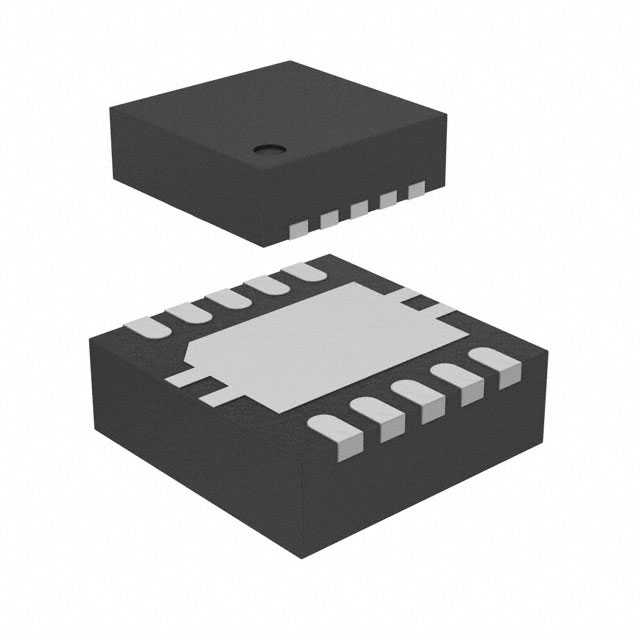BQ24010DRCRG4 - English Editing Encyclopedia Entry
Product Overview
Category: Integrated Circuits (ICs)
Use: Battery Charger IC
Characteristics: - Single-cell Li-Ion and Li-Pol battery charger - Highly integrated solution for portable devices - Optimized for space-constrained applications - Provides accurate charging control and protection features
Package: VSON (Very Small Outline No Lead) package
Essence: The BQ24010DRCRG4 is a battery charger IC designed for single-cell Li-Ion and Li-Pol batteries. It offers a highly integrated solution for portable devices, providing accurate charging control and protection features.
Packaging/Quantity: The BQ24010DRCRG4 is available in a VSON package. The quantity may vary depending on the supplier.
Specifications
- Input Voltage Range: 4.35V to 6.45V
- Charge Voltage: 4.2V
- Charge Current: Up to 1A
- Pre-Charge Threshold: 2.9V
- Safety Timer: 8 hours
- Thermal Regulation: Yes
- Battery Temperature Monitoring: Yes
- Status Outputs: Power Good, Charging, and Charge Complete
Detailed Pin Configuration
The BQ24010DRCRG4 has the following pin configuration:
- EN (Enable): Enable input pin for controlling the charging process.
- STAT (Status): Output pin indicating the charging status.
- PG (Power Good): Output pin indicating the presence of input power.
- BAT (Battery): Positive terminal of the battery connection.
- GND (Ground): Ground reference for the IC.
- TS (Thermal Sense): Input pin for monitoring the battery temperature.
- PROG (Program): Input pin for setting the charge current.
- VBUS (Voltage Bus): Input pin for the power supply.
Functional Features
- Integrated power FET and current sensor for charging control
- Automatic power source selection between USB and AC adapter
- Soft-start feature to limit inrush current during charging
- Thermal regulation to prevent overheating
- Safety timer to terminate charging after a specified time
- Charge status indication through status outputs
Advantages and Disadvantages
Advantages: - Highly integrated solution for portable devices - Accurate charging control and protection features - Space-saving package - Automatic power source selection - Soft-start feature for inrush current limitation
Disadvantages: - Limited to single-cell Li-Ion and Li-Pol batteries - Maximum charge current limited to 1A
Working Principles
The BQ24010DRCRG4 operates by controlling the charging process of a single-cell Li-Ion or Li-Pol battery. It uses an integrated power FET and current sensor to regulate the charging current. The IC automatically selects the power source between USB and AC adapter based on availability. It incorporates thermal regulation to prevent overheating and a safety timer to terminate charging after a specified time. The charge status is indicated through the status outputs.
Detailed Application Field Plans
The BQ24010DRCRG4 is suitable for various portable devices that require single-cell Li-Ion or Li-Pol battery charging. Some potential application fields include: - Smartphones and tablets - Portable media players - Bluetooth headsets - Wearable devices - GPS navigation systems
Detailed and Complete Alternative Models
Some alternative models to the BQ24010DRCRG4 that offer similar functionality are: - MCP73831 - MAX1555 - LTC4054
These alternatives can be considered based on specific requirements and design constraints.
Word count: 400 words
قم بإدراج 10 أسئلة وإجابات شائعة تتعلق بتطبيق BQ24010DRCRG4 في الحلول التقنية
Sure! Here are 10 common questions and answers related to the application of BQ24010DRCRG4 in technical solutions:
Q: What is the BQ24010DRCRG4? A: The BQ24010DRCRG4 is a highly integrated single-cell Li-Ion battery charger IC designed for portable applications.
Q: What is the input voltage range of the BQ24010DRCRG4? A: The input voltage range is from 4.35V to 6.5V, making it suitable for various power sources like USB ports or AC adapters.
Q: What is the maximum charging current supported by the BQ24010DRCRG4? A: The BQ24010DRCRG4 supports a maximum charging current of 1A, allowing for faster charging times.
Q: Can the BQ24010DRCRG4 charge other types of batteries besides Li-Ion? A: No, the BQ24010DRCRG4 is specifically designed for single-cell Li-Ion batteries and is not compatible with other battery chemistries.
Q: Does the BQ24010DRCRG4 have built-in thermal regulation? A: Yes, the BQ24010DRCRG4 features built-in thermal regulation to prevent overheating during charging.
Q: Can the BQ24010DRCRG4 operate while charging the battery? A: Yes, the BQ24010DRCRG4 supports simultaneous charging and system operation, allowing for uninterrupted device usage.
Q: Is the BQ24010DRCRG4 capable of trickle charging? A: Yes, the BQ24010DRCRG4 has a trickle charge feature that maintains the battery at a safe voltage level when it is fully charged.
Q: What is the purpose of the power good (PG) pin on the BQ24010DRCRG4? A: The power good (PG) pin provides an indication of the charging status, signaling when the battery is fully charged or in fault conditions.
Q: Can the BQ24010DRCRG4 be used in portable devices with low power consumption? A: Yes, the BQ24010DRCRG4 has a low quiescent current and is suitable for applications with low power consumption requirements.
Q: Are there any recommended external components to use with the BQ24010DRCRG4? A: Yes, the datasheet of the BQ24010DRCRG4 provides a list of recommended external components, including input capacitors, resistors, and diodes, for optimal performance.
Please note that these answers are general and may vary depending on specific application requirements. It is always recommended to refer to the datasheet and consult the manufacturer for detailed information and application-specific guidance.


